You can preserve vegetables in different ways and it is easy! Preserving vegetables not only makes good business sense but also contributes to reducing food waste. It extends the shelf life of fresh produce and minimizes spoilage, ensuring more of the harvest reaches our tables.
If you live in areas that enjoy four distinct seasons, the end of summer often evokes bittersweet feelings. While it signifies the conclusion of the growing season, it is also the time to harvest the fruits of your hard work.
After that, storing and preserving your vegetables in the right way increases their shelf life. Armed with the right tools and a dash of know-how, you’ll be relishing fresh veggies even when the snow blankets the ground outside.
Let us dive into some popular ways to preserve vegetables and make them available almost all year round!
How to Preserve Vegetables
In the olden days, people stored and preserved their harvest in traditional ways. However, we have more advanced, secure ways for that today. The National Center for Home Food Preservation sets the standards for this purpose.
Preserve Vegetables by Freezing Methods
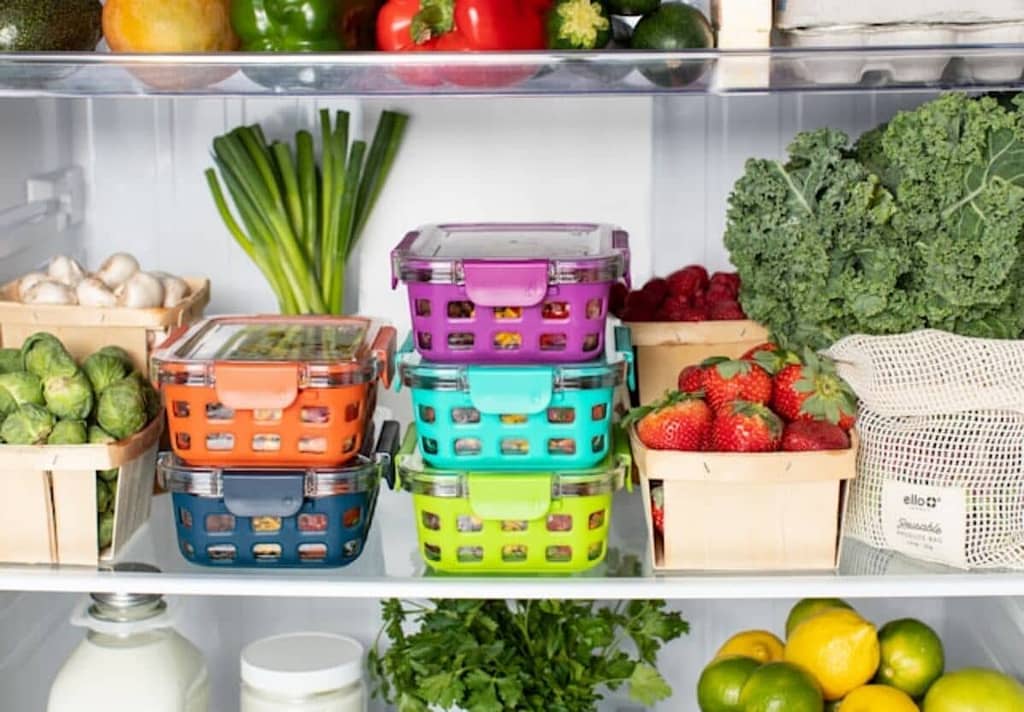
By freezing, you can preserve vegetables and fruit. Some vegetables such as broccoli, string beans, okra, leafy greens, and asparagus require blanching before freezing. Otherwise, your vegetables would become soft, soggy, and lacking in texture, often due to excess moisture retention or cell breakdown.
Different vegetables have different blanching timings. Blanch your vegetables for just the right time before freezing to lock in freshness. This simple step keeps them colorful, flavourful, and packed with nutrients.
Generally, blanching stops or slows down the enzymes that cause spoilage. It also wilts vegetables, allowing them to fit more compactly in freezer containers.
Root vegetables including cabbage, potatoes, celery, cress, endive, lettuce, and cucumbers do not freeze so well.
Fruits mostly do not require blanching. But this process helps pealing produce like peaches, apricots, nectarines, etc., easier.
How to Blanch Vegetables
For home freezing, you can either opt for water blenching or steam clenching.
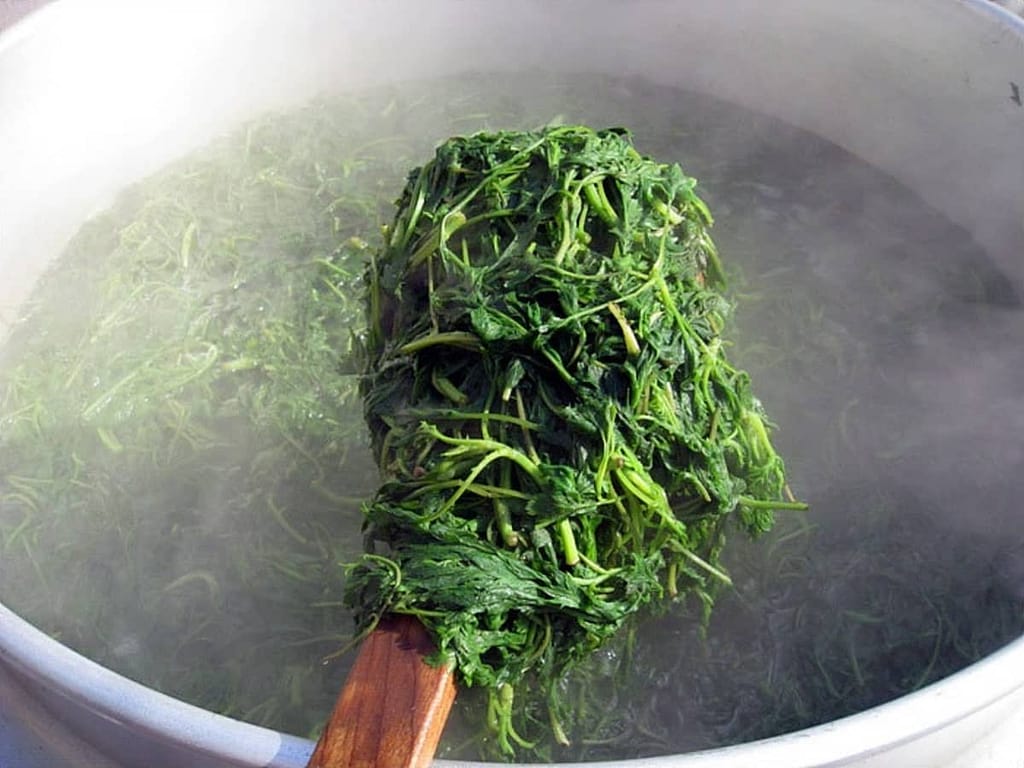
경빈마마, Blanching Korean mugwort, CC BY 2.0 KR
Water Blanching
Most home cooks can use a large pot with a lid and a wire basket for water blanching. For a more specialized setup, a blancher with its own basket and lid is also an option.
Fill a large pot with water, aiming for 1 gallon for every pound of prepared vegetables. Bring it to a rolling boil.
While the water heats, place your vegetables in a blanching basket. Once boiling vigorously, carefully lower the basket into the pot and secure the lid.
Start your timer only after the water returns to a full boil. Keep the heat on high setting and blanch the vegetables for the recommended time based on the specific vegetable you’re freezing.
Heat Steaming
Heat steaming usually takes 1½ times longer compared to water blanching. Some vegetables, like mushrooms, broccoli, and summer squash (including zucchini), benefit from heat steaming.
Grab a large pot with a tight-fitting lid and a steamer basket that holds your veggies at least 3 inches high from the bottom. Pour about one or two inches of water into the pot and start boiling the arrangement.
After that, arrange your vegetables in a single layer inside the basket to ensure even steaming. Quickly cover the pot with the lid and set the heat on a high level. Start your timer at this stage and steam for the recommended time based on the specific vegetable you are working with.
Blanching time varies for different types of vegetables and their sizes. Under-blanching stimulates the passive enzymes and over-blanching leads to loss of color, flavor, and nutrients.
After blanching, it is essential to cool the vegetables promptly to halt the cooking process. To do this, immerse the vegetable basket in a generous amount of cold water—adding ice cubes (1 pound of ice per pound of vegetables) is effective.
The cooling time should match the blanching duration. Finally, ensure thorough drainage after cooling, as excess moisture can compromise the quality of frozen vegetables.
Microwave blanching
Most experts do not recommend microwave blanching. Studies have demonstrated that certain enzymes may remain active, leading to loss of color, flavor, and texture. Additionally, microwave blanching has not been proven to be more efficient in terms of time or cost.
Preserve Vegetables by Fermentation
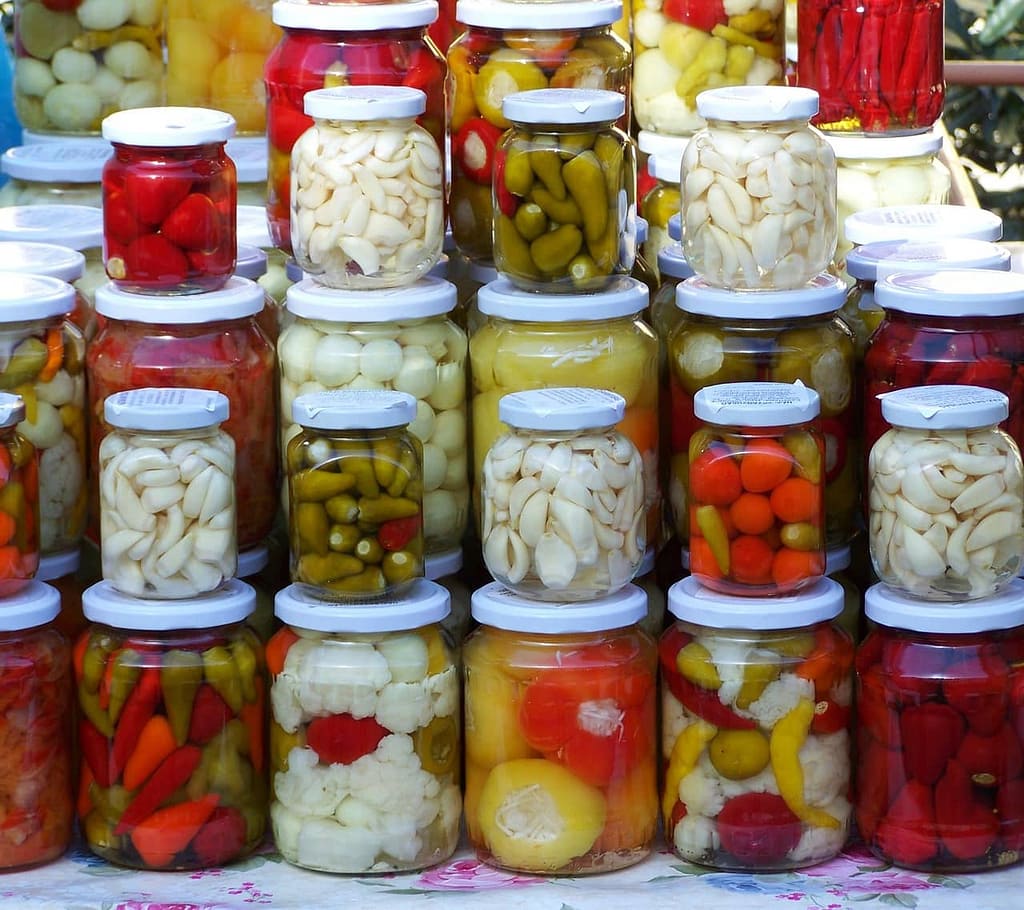
Since ancient times, people have used different techniques to preserve vegetables. Fermentation is one among them. With modern supplies, this easy process becomes even simpler.
In this process, microorganisms create alcohol or acids that neutralize harmful pathogens. They also change the texture and flavor of the food, aiding the digestion process. Here are some simple ways of fermentation:
Preserve Vegetables by Pickling
You can pickle almost all types of veggies from cucumbers to peppers. Two common ways of pickling are quick pickling and water bath canning.
Quick Pickles: You can prepare quick pickles or refrigerator pickles easily and quickly. However, you should consume them quickly as they lose crunchiness over time.
Heat the water until it steams. Then, add and stir salt until it dissolves. Finally, add vinegar and stir for some time. The resulting liquid is called brine.
Place the veggies or fruits in a lidded non-reactive container like a glass or ceramic jar. Then, pour the brine liquid until it covers the ingredients fully. Allow the arrangement to cool to natural room temperature.
Close the lid and place the jar in a refrigerator. Wait at least for 2-3 hours before consuming so that the ingredients pickle well inside the jar.
Canning: This helps extend the shelf life of quick pickles up to one year. This process involves placing your pickle jars in a boiling water bath for a designated time, typically around 10 minutes.
This process forces air out of the jars, forming a vacuum seal as they cool. This lack of oxygen prevents the growth of yeasts, bacteria, and mold, keeping your food safe from spoilage
In fact, there are two methods of canning – Water-bath and canning and Pressure canning. Low-acid foods require pressure canning, while high-acid foods can be done with either pressure canning or water bath canning.
Other Fermented Foods
Fermentation preserves food. Moreover, it helps to prepare delicious foods like kimchi and sauerkraut. These fermented foods are packed with beneficial bacteria (probiotics) that aid digestion, boost immunity, and contribute to overall health!
Preserve Vegetables using Drying Methods
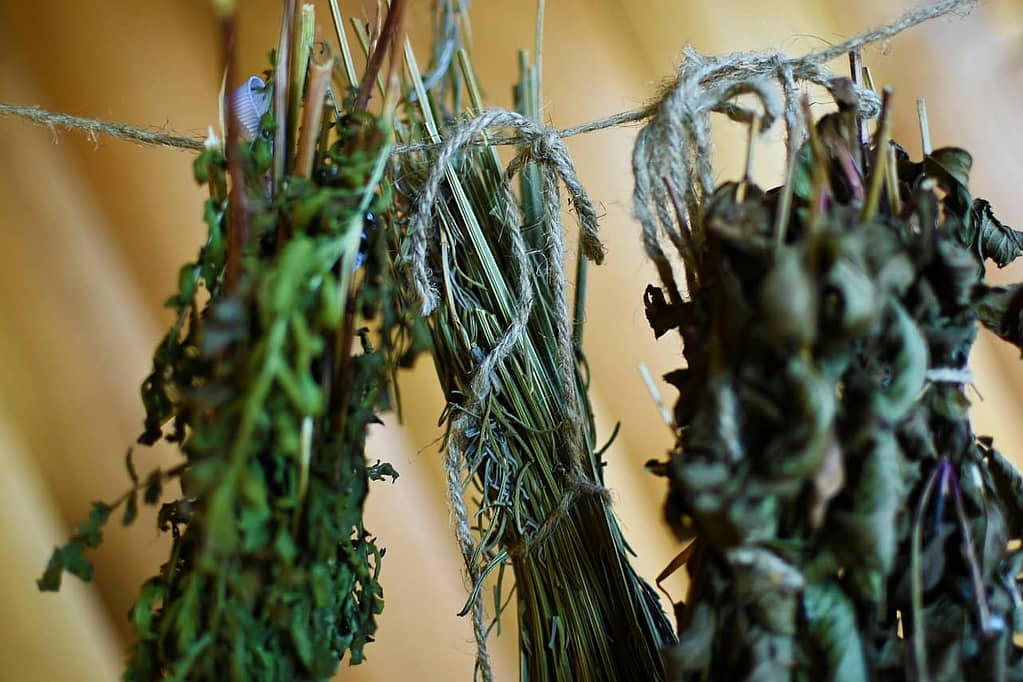
This is one of the ancient preservation methods that is still in use. Depending on the type of vegetables, the drying process may vary a bit. The invention of modern equipment has resulted in more effective drying of produce.
Drying Herbs
Another ancient, easy method of food preservation is drying. During drying, aim to remove just enough moisture to prevent spoilage without sacrificing the vegetable’s delicious flavor.
Air Drying
When it comes to herbs, simply place them in a spacious paper bag. Then, hang it in a well-ventilated, warm spot, until the herbs crumble easily. Finally, store the crumbled herbs in a covered glass container. Keep the arrangement out of heat and direct sunlight.
You can also use microwaves for this purpose. But be careful as different microwaves have different settings of heat. Miscalculated settings may cause extreme heat that can burn or scorch the herbs.
Far worse, the heat can set paper bags or paper towels on fire and damage the oven itself. So, it is best to stick with air-drying, for the safest results.
Drying Vegetables
Air-drying does not work well for all veggies, especially in highly humid environments. Therefore, you can opt for heat-drying them using ovens or dehydrators.
Oven (Heat Drying)
Clean the veggies well and dry them with a soft towel. Cut off stems, rinds, and other damages from vegetables. Remove pods of veggies like peas and beans. Slice down veggies like squash, tomatoes, and sweet peppers. Finally, blanch them thoroughly, before heat drying.
Place a baking sheet inside the oven. Spread the veggies or fruits in a single layer on it. Turn your oven to its lowest setting, typically around 150°F (65°C). Slightly open the oven door and leave it that way throughout the process. This helps moisture to escape
Depending on the items, the drying times vary. Herbs can take just a few hours, while some fruits and vegetables might need up to a day. Your produce is done, when it appears wrinkled, shriveled, and feels leathery
Food Dehydrator (Heat Drying)
The drying process is the same in dehydrators as in ovens. However, the food dries more quickly and professionally with this equipment. Depending on the items, the drying times vary between a few hours to 12 hours. Make sure to follow the instruction booklet for timings on specific items.
Making Preserves
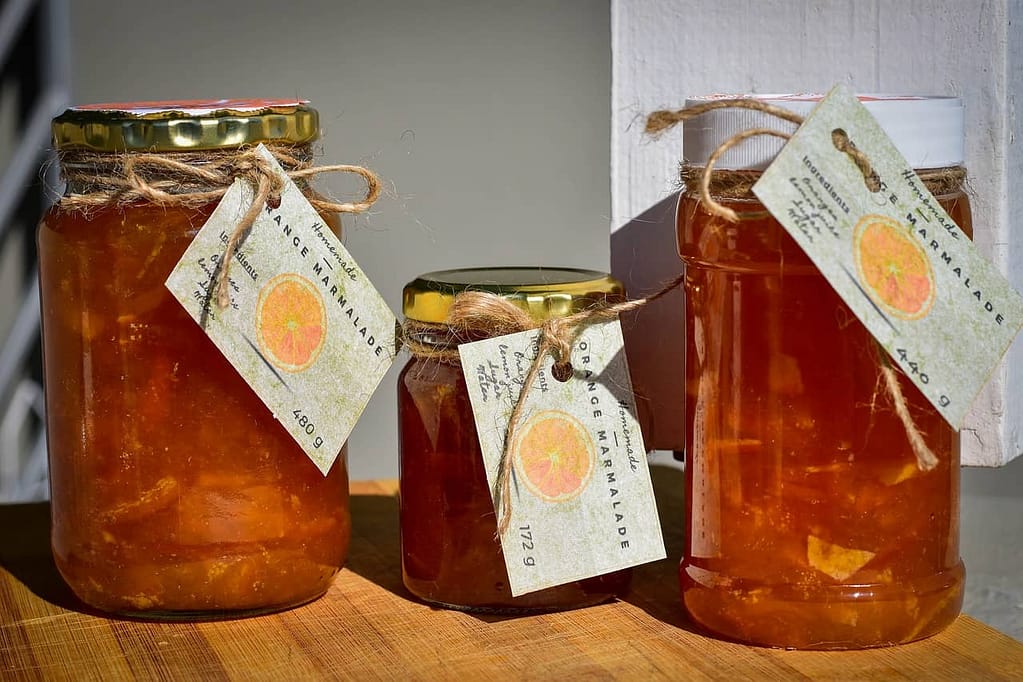
You can also preserve vegetables and fruits by making preserves like sauces, jellies, jam, chutneys, and compotes.
Jam: Jam is a spread made by cooking fruit with sugar until it thickens. It is a great way to preserve fruit and enjoy its flavor year-round. Think of it like a thick, spreadable jelly with bits of fruit in it.
Jelly: Jelly is a sweet, jiggly dessert made from fruit juice, sugar, and a thickening agent like pectin or gelatine. Unlike jam, jelly is smooth with no fruit chunks. It is a common spread for toast or a light and refreshing dessert.
Sauce: A sauce is a flavourful liquid, cream, or semi-solid food typically used to enhance other dishes. It adds moisture, taste, and visual appeal. Think of it as a flavor booster for your food!
Compotes: A compote is a dessert made by slowly cooking fruit in sugar syrup. It often includes spices or citrus zest for added flavor and can be served warm or cold. Compotes are typically enjoyed with yogurt, ice cream, pancakes, or as a topping for various desserts.
Chutney: A chutney is a condiment, like a relish, made with fruits, vegetables, herbs, and spices. Depending on the ingredients used, It can be chunky or smooth, sweet, savory, or spicy. While most chutneys are spicy, you can adjust the heat factor when making it at home. Chutneys are often used to enhance the taste of main dishes, appetizers, and snacks.
Most preserves have sugar and natural preservatives (pectin, citric acid) to extend the shelf life. Enjoy these delicious preserves in moderation. They are a tasty treat, but for a more nutrient-rich option, consider fresh or frozen fruits
Preserving Herbs and Leafy greens
Preserving herbs and leafy greens is a great way to enjoy them year-round. It is surprisingly easy and effective too!
Freezing Herbs – Herb Vase
Preserving fresh herbs around is surprisingly easy! It is one of the simplest ways to preserve food. Here is a trick: wrap damp paper towels around the stems of your herbs, like asparagus. This will keep them fresh longer.
Alternatively, plant them upright in a glass containing about one inch of water. This slows the wilting process down and ensures hydration.
Soft Herbs: Plant herbs like coriander, parsley, mint, dill, and basil upright in a glass with an inch or two of cool water, at room temperature. Additionally, you can chop up leftover herbs, pop them in an ice cube tray, fill it with water, and freeze it. Later, as needed, add herb-filled cubes to your cooking
Hard Herbs: Refrigerate herbs like thyme, rosemary, sage, and chives to enhance their shelf life. To keep them extra fresh, wrap them in a paper towel (no need to get them wet this time) and then pop them in resealable bags or airtight containers. This keeps them fresh and ready to use in your cooking.
Leafy Greens
To keep bagged salad fresh for longer, transfer the leaves to a storage container or a bowl. Place a few sheets of kitchen paper on top, then tightly wrap the container with cling wrap or wax paper to reduce air exposure.
Then, place the arrangement in a fridge. This method helps maintain the salad’s crispness and prevents wilting in the fridge.
To make lettuce last longer, separate the individual leaves and soak them in cold water for a few hours. Then, rinse and dry them gently. You can use a salad spinner if you have one, for this purpose.
Spread the individual leaves on a clean cloth (a dish towel works too!). Roll up the cloth with leaves tightly and place it in a large, resealable food container. Place this container in a refrigerator. This keeps your lettuce fresh and ready to use in salads as needed.
Preserve Vegetables by Storing
Store your vegetables in a cool, dark, and well-ventilated space to maximize their shelf life. A root cellar or dry cabinet is ideal, but any pantry or basement will do in a pinch. Just make sure it has good ventilation to prevent the build-up of moisture.
Heat, light, and humidity spoil most fresh produce faster. Therefore, store your vegetables away from them.
You can store some root crops like carrots and beets in a large container, with moist sand filling. In colder regions, just leave root crops in the ground over winter. Cover them with a thick layer (12-18 inches) of mulch-like leaves or straw for insulation. This keeps them good throughout winter.
Curious Contemplations
Harvesting Vegetables
Vegetable Garden




